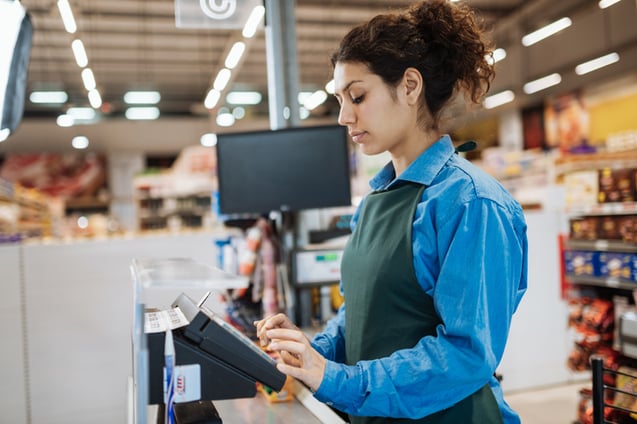If you are running a business where you have a mixture of ‘trade’ and ‘wholesale’ sales, there are some must-have features you need in your ePOS system or trade counter software to enable you to run both efficiently and effectively.
Most accounting, business management and ERP software packages are feature rich when it comes to the wholesale side of the business, with well-thought-out sales order processing systems. But operating a trade counter is an entirely different proposition with a whole other set of challenges at play, so it’s important that your software complements the way you do business at the point of sale.
The following list outlines the important features that deliver benefits in terms of tighter control, higher margins, faster processing, and enhanced customer service. Assess your current trade counter operation against the following criteria and see if you are in control…
Individual user login and password control
Does your system give you the option to prompt users to log in at each transaction? This is essential where multiple users are using the same terminal and you require the system to store details of who processed each transaction. It’s also important if you want to print the rep’s name on each docket or would like to view sales information per rep.
Suspended items
Does your system give you the option to “suspend” a sale and recall it at any terminal? In a typical trade counter environment, a customer may be at the counter with a selection of products when they request the rep to accompany them down to the shop floor or store room to look at another product. As such, your system should allow the user to temporarily suspend the transaction and recall it at any other terminal when ready to do so.

Access to cost price
Does your system give users the option to access “cost price” information? For some of you, this is a total no no. For others, where the owner-manager is doing the transaction or staff are encouraged to understand the cost information, it can be beneficial to provide access to this information quickly and efficiently without leaving the point in the transaction.
Sales history
Does your system allow users to easily access pricing history at the point of sale? In many instances, the price on the point-of-sale screen may be disputed by the customer by referring to prices previously paid for the same item. It’s important that the user can access the historical sales information with one or two keystrokes to clear up any confusion.
Cash customers
Does your system allow for cash sales from the same interface? In most trade counter environments, there will be a mixture of cash and trade business. It’s important that your system allows you to process a cash and trade sale quickly and efficiently from the same screens following individual sets of rules.
Cash on delivery
Does your system facilitate cash-on-delivery-style transactions? It’s not untypical for customers to place substantial orders and promise payment on delivery. As well as prompting for some element of a delivery charge, it’s important this COD account is actively managed so that it doesn’t become another debtor.
Rapid order entry
Does your system allow for speedy entry of repeat or predictable orders? Where a tradesman is buying a range of similarly coded products or a customer is ordering frequently purchased items, it is important that your system facilitates this rather than forcing the user to re-enter the information.

Margin control
Does your system assist you in maintaining your margin or your sales? It’s important that your system is proactively assisting you in maintaining margin levels.
Where multiple salespersons are processing transactions, it’s not possible for the manager to monitor each and every sale. As such, the system should have minimum margins per product; maximum discounts that a rep can give; password-protect larger discounts; effective reporting to highlight low-margin sales; and tools that will allow for maximum margins to be attained.
Haggle
Does your system provide enough information for you to “haggle” for the best deal? In a competitive sales environment, it’s important that the sales rep has access to information that will allow them to debate a price with the customer. Access to cost price, margin, discount levels, and the ability to perform what-ifs on the fly can result in very effective negotiations, even in a customer-facing scenario.
Quick find customers and products
Does your system allow you to easily find customers from your database at the point of sale? Your system should allow you to quickly find a customer record by searching using all, or part, of the name, address, phone number or contact details. This is essential for speedy order processing and improved customer service.
The same applies to product searches – in a trade environment, it’s not practical to scan barcodes for all products. It should be possible to find a product by using some of the name, by identifying the product group, or by working your way through a “tree” structure using alternative or manufacturer part codes, etc.
Ability to Choose Price Band
Depending on the application, it may be useful for your sales staff to choose the “Price Band” on the hoof to provide the initial prices on a transaction.

Alternate and related products
It’s useful for a system to prompt the staff member with alternatives available for certain products. You may have a customer who is purchasing a drill from a well-known brand name but there may be a higher-spec drill available at a cheaper price that you can offer. The system should prompt the user with this information so that it can be used to please both the customer and the owner. Plus, this is also a great opportunity to upsell related items and accessories.
Customer and product selection messages
Your system should allow you to enter customer-specific information presented to any salesperson engaging with the relevant customer so as not to miss opportunities, e.g., “Tell Richard that we have a special offer on insulation until the end of the month”. Similarly, you can add product-specific prompts, too, including low-stock alerts or warnings.
Alert if a quote exists
Where a system is used to its fullest, it should be possible to alert sales staff that a customer has had a quote previously for an item that they’re purchasing. Your system should prompt the user with a message like “a quotation already exists for this item”’ when a product has been chosen for which there is an associated quote. This leads to much better customer service and may mean a higher margin sale.
Force customer reference number
In many instances, customers can use the lack of a PO number as a reason to delay or confuse a payment. Your system should allow you to set a customer-specific required field so as not to allow a transaction to be processed unless a PO number has been entered.

Choose from multiple delivery addresses
This is important when you are dealing with a tradesman or company working on several different sites at the same time. It should be possible to store a list of the different delivery addresses on your system to save having to type the address each time there is a transaction. Printing this information on the dockets is also of immense value to the customer who has to sort through their invoices for their own system.
Credit check
One of the basic requirements of any trade counter ePOS system is to extend and support the credit control process in the business. Most companies favour a traffic-light approach where customers can be placed on “stop” immediately when they exceed their credit limit; the “amber” approach is where the user is prompted to alert the customer but continue with the transaction and the “green” scenario is when the account is in order. There should also be an option to include “Unbilled” and “On order” amounts in the credit control check.
Customer ledger easily accessible
It is important for users of ePOS systems to be able to access detailed account information from that point. It should be possible to access line items on invoices from the POS and reprint invoices as requested or view payment allocations.
Multiple payment types
Customers can present a variety of types of payment at the POS and it is important that a system allows for this and produces the necessary reconciliation features for end-of-day reporting.
End-of-day reporting
XRead and ZRead – although most systems offer either Trade Counter or ePOS solutions, it’s important that your trade counter operates like a retail “till” centre. Cash and end-of-day reconciliation is important for a variety of reasons and should be a standard feature of any system.

Multiple docket layouts
There are many instances when it’s useful to provide different layouts for dockets at the electronic point of sale. Some customers may insist on a docket that shows the discount levels achieved on the transaction while others will query prices if a discount column is shown. It’s also useful to offer a small receipt alongside a VAT Docket to avoid unnecessary printing.
Rounding discounts
It’s important that the sales rep at the POS can offer a rounding discount. The system should allow for this without the need for the rep to have to calculate the net + VAT equivalent and deal with the annoying differences. They should be able to simply type in the gross amount and the system should handle the VAT split in the background. From a margin perspective, it may also be necessary to apportion the discount across the line items.
Highlight special prices
When putting together a transaction that has a large number of lines, it’s useful to be able to quickly identify which lines are already on “special pricing” so that a valuable margin is not given away to secure the deal. Lines which already have been given special prices should be clearly visible at the POS.
Access accurate stock information
Trade counter personnel deal with a wide variety of queries from numerous sources. It’s important that the system supports them in their role by providing them with access to this information quickly and smartly.
The ability to access stock-level information quickly at the POS is a fundamental requirement and your system should support this. Trade counter personnel may also have to answer queries relating to customer and supplier accounts, outstanding orders, the validity of quotations, stock due dates, etc., so it’s important that a system supports them in this.
Unsure what to look for in a merchant ERP software system? Read our Definitive Guide to Merchant Software – it has all you need to know. Alternatively, if you’re ready to invest in business management software that will help to future-proof your operations, contact the Intact team today for a free software demo.





